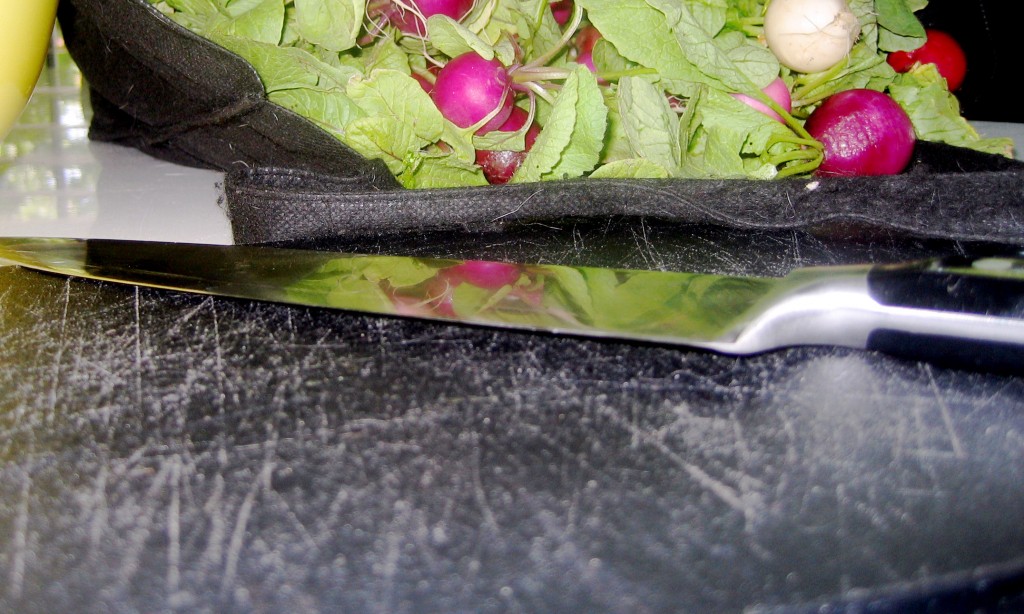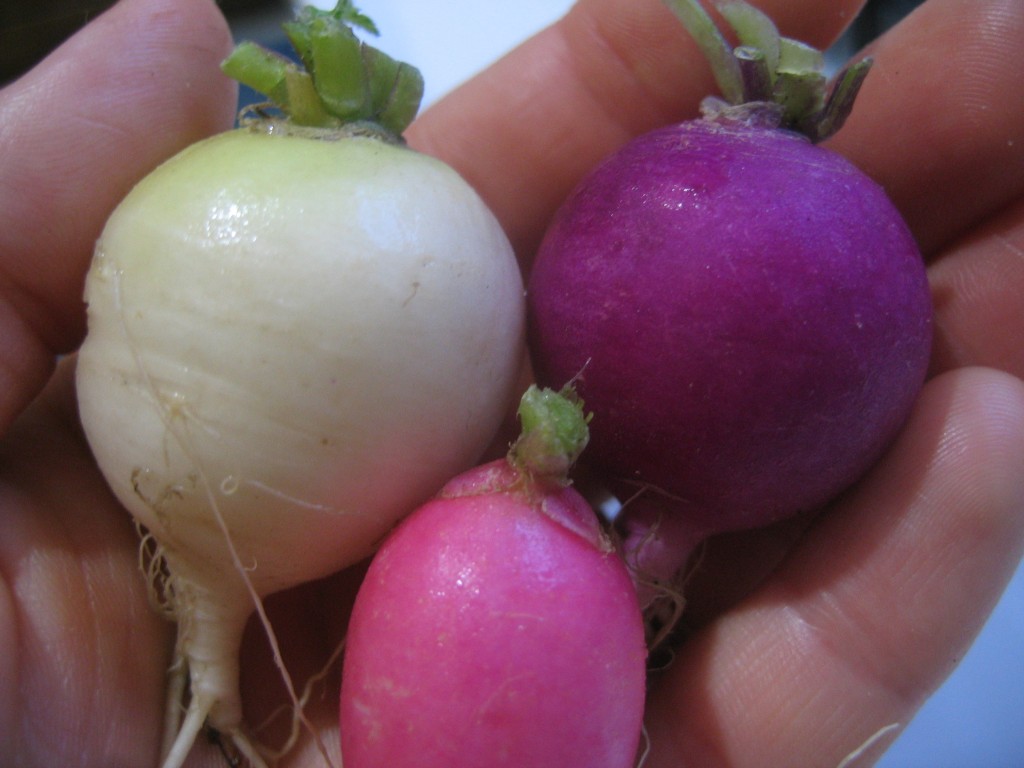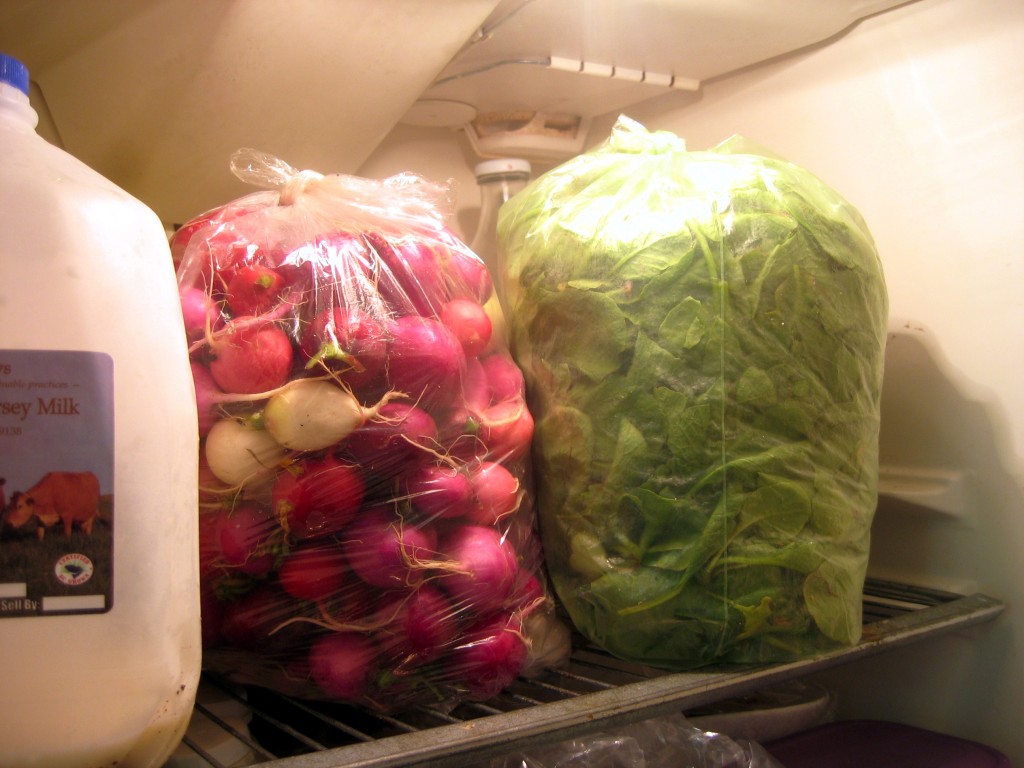How to Store Radishes, Carrots, Beets, and Turnips
 The decline of home cooking has become a trendy thing to complain about these days. If only more people would cook at home, the argument goes, we could begin to solve such national problems as obesity, diabetes, and the falling economy. But very little is being done to actually make that happen. Yes, Jamie Oliver taught 1,000 people how to cook in a week. But unless you happen to live in Huntington West Virginia, you are stuck with the commercials in between the shows. You know, the ones that claim Stouffer’s and Lean Cuisine and necessary to make healthy daily meals, because working with raw ingredients is too intimidating and best left to the professionals.
The decline of home cooking has become a trendy thing to complain about these days. If only more people would cook at home, the argument goes, we could begin to solve such national problems as obesity, diabetes, and the falling economy. But very little is being done to actually make that happen. Yes, Jamie Oliver taught 1,000 people how to cook in a week. But unless you happen to live in Huntington West Virginia, you are stuck with the commercials in between the shows. You know, the ones that claim Stouffer’s and Lean Cuisine and necessary to make healthy daily meals, because working with raw ingredients is too intimidating and best left to the professionals.
There is a huge gap in general knowledge not only in the basics of cooking, but in how to store raw ingredients. People seem to fall into two extremes when it comes to veggie storage. There is the Seal Everything Tightly In A Ziploc Bag So It Doesn’t Get Contaminated camp and then there is the Throw Everything In The Fridge Exactly How It Came From The Store And Hope For The Best camp. And it’s no wonder there is such confusion. Meat and dairy products are the only foods that come with explicit storage instructions - instructions that make it sound like if you look at the ground beef in your fridge and think “salmonella,” the cells with magically begin to spawn. Then we have the likes of Food Network fridges that are always cascading with fresh vegetables, wholly intact down to the carrot tops waving at the camera, nary a bag in sight.
I’ve spent some time in both camps. Neither of them served me well. I’d either end up with a amoeba-ish slimy mess in my bags or dried out mummified versions of food left loose on the shelf. There is nothing more frustrating than buying beautiful fresh food and having it transform into inedible slime or wood chips in your fridge. In reality, each vegetable has different needs when it come to storage. These needs include packaging, location, and pre-storage prep.
In order to clear up that confusion, I am starting a How to Store Your Food series. Whenever I post a recipe using a new ingredient, I will also add a short post explaining how to store that food. These posts will be tagged with “How to store your food,” so they will be easy to find.
On that note . . .
How to Store Radishes, Carrots, Beets, and Turnips
Radishes, carrots, and turnips are all root vegetables. That means that the part that we are most familiar with eating is the root of the plant. That means several things for the cook.
- First, it means that there is a whole leafy “plant part” of the vegetable that needs to be taken care of. Depending on how you buy your vegetables, this step may or may not apply to you. If your carrots, radishes, ect have leaves and stems attached to them, it applies to you. If they don’t, skip to step three. As soon as you get your leafy root vegetables home, cut the leafy plant part off. Why? Well, think back to your third grade plant science. The root part’s job is to collect moisture for the plant part. The plant part then sucks the moisture out of the root part. This system works in the ground because there is always (hopefully) more moisture in the ground for the root to replenish what the plant takes. But once it is harvested, that cycle stops. So, if you leave the leafy plant part attached to the root part for very long, the plant is going to suck the root dry. You might have carrot tops waving at you when you open the fridge door, but you will also have a spongy, withered, not-at-all-crisp carrot. I know it’s pretty and satisfying to have that bundle of fresh carrots laying on your shelf like a lithe sunbather, but do yourself a favor and cut the tops off. Leave about 1/2- 1 inch of the stem intact. Your vegetables will look like they’ve all had buzz cuts.

- Put the greens in a loosely sealed plastic bag in the fridge. They should be totally dry. Don’t wash them until you are ready to use them. Remember, water equals slime. Try to keep the bag either in the crisper drawer or on the back of the bottom shelf. They will keep about a week.
- You now are left with just the root part of the vegetable. The most common way to store them is in a loosely sealed plastic bag. (A separate one from the greens). The bag then goes in the crisper drawer. Stored this way, the vegetables will keep about week, carrots a little longer. Then there is the less orthodox way outlined by the high priest of kitchen hacks, Alton Brown. Because these are roots, he reasons, they will be most at home in a dirt like environment. Therefore, he suggests filling one of your crisper drawers with . . . sand. You then bury your vegetables in the sand. He swears he’s kept root vegetables crisp and fresh in this manner for months. Theoretically this makes sense because you are basically creating a mini root cellar. I’ve not personally tried this method yet because, silly me, I keep misplacing my extra pile of excess sand. But someday, I plan on it. If you decide to give this method a shot, let me know how it goes. For now, my roots go plastic bags

Tags: How to store your food, Radish, The Ravishing Radish Challenge

That was very helpful!
Great just what I needed. thank you
Great just what I needed. thank you. I love root veggies
Thank you for that great advice….only now I’m going to have to also try the sand method.
Thanks for the good info – I just came home with radishes and beets from our local farmer’s market and needed to know the best way to keep them fresh.
thanks for info. I always wondered why radishes (with the leaves) get so slim!
Sorry if this is covered elsewhere in your blog, but how do you feel about those green produce storage bags?
Thanks….i wondered why they were turning wimpy!
Thanks! I knew my mother was wrong.
gotta love alton brown. the whole sand thing is genius. been craving a root cellar, but doesn’t look like i’ll get one of those anytime soon
Hi, just wanted to say thanks for this post; it was very helpful, and funny too. Now I know!
Thanks! very helpful
Okay, well, I have 2.5 refrigerators and a blue billion radishes I grew, so I WILL try the root cellar method and I WILL report back!!!!!! The group can count on me!!!
Thank u for the info
I look forward to your website on storing foods … so needed!
What will u call it! please let me know.
Again, thank u! and good luck with your new site. I am sure it will be a big success!
E. (Buffy) Mullin
A-1 advice. Sand does work for potatoes. Just planted my fall turnips.
This is good information but I’ve got my first real garden going great and have about 200 radishes begging to be picked. I don’t think that I can eat that many that quick (or want to). I don’t think the bottom drawer in my fridge, or anyone else’s can handle being filling with sand. Probably 150 lbs. Gardening is fun though.
A funny story….I am 42 years old and until last year I thought you could grow radish in sand…I told my Mum this and she laughed. My memory of her ‘harvesting’ radish from the sand box in the greenhouse was indeed where they very successfully stored them. So often the old ways are the best so give it a go….I don’t even think it needs to be in a fridge. Try a dark garage or shed!
We have an extra refrigerator in the garage and I thought of trying Altons way. Does he bury them with or without the greens attached?
Melissa,
You’d want to cut the greens off. They make the roots rubbery.
sand in the fridge! i will definitely try it
. til then,the darn roots go out in a basket on the back porch. nice and cool in this early fall weather. i like your site.
Thank you! This is exactly what I needed. And, now I will have to try the sand method.
Thank you. I like the pictures too.
O.K. so I have already removed all the green and the roots leaving the turnips but not not yet peeled. I did peel some all the way and have them in a plastic container in the fridge. Is there any hope aqt storage of the rest in a cool dark room and in ?bly stockings to preserve them for as needed use?
Thank you all so much.
well here goes. i use layers of hay to store any root crop in my barn. its great thru the winter and i empty it out in the spring for friends etc. im in central america and if you harvest turnips in late nov. or early dec. this works well. in the city i used a storage shed.good luck and please take off the tops. you can cook them and freeze wow they are awesome.
thx for the info and the laugh about sand…but seriously, if i had sand, i’d bury my 4 turnips in them inside a gallon size ziploc or large plastic container! too funny! LOVE alton brown!
I seriously grew up on packaged food so I’m new to cooking. Sorry if this is a dumb question, but what do I use the greens from the radishes for?
Not a stupid question at all! If they’re not too fuzzy, you can add them to salads for a zippy bite. Or mix them with other greens like kale or collards and cook them.
The sand sounds right, but it comes in lots of flavors and grain size. I would expect beach sand to contain salt and crude oil. I suspect that
lime stone and uranium sands would have differing properties and influences on the food stored in them. So where do you get your sand, and what is it made of? If you clean it, how is that done?
I successfully kept a couple dozen potatoes in a two-gallon wooden box at room temperature in the same (dry) dirt (not sand) in which they grew.
Ok we have eaten all the radishes and Im over them for now. I currently have an overload of turnips so Im looking for good storage ideas. Several yrs ago I found a website that told you how to can turnips or as we call it (put up). All I can say if DO NOT try this method. Oh boy come fall I had a total mess. All my jars of turnips turned black. No way were they eaten so into the mulch pile of scraps they went. Does anyone know if it is possible to freeze turnips? If so please let me know.